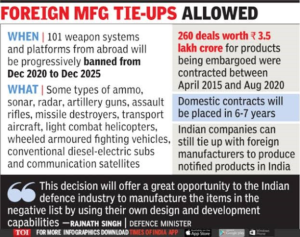In News: The Defence Ministry announced a list of 101 items that it will stop importing.
Negative Imports List for Defence
- It essentially means that the Armed Forces—Army, Navy and Air Force—will only procure all of these 101 items from domestic manufacturers.
- The manufacturers could be private sector players or defence Public Sector Undertakings (DPSUs).

Why such a decision?
- Reduce imports: As per the Stockholm International Peace Research Institute, which tracks defence exports and imports globally, India has been the second-largest importer between 2014 and 2019 with US$ 16.75 billion worth of imports.
- Boost domestic industry: By denying the possibility of importing the items on the negative list, the domestic industry is given the opportunity to step up and manufacture them for the needs of the forces.
- Boost exports: The government has been hoping that the defence manufacturing sector can play a leading role in boosting the economy, not just for the domestic market, but to become an exporter as well.
Items included in the negative list
- water jet fast attack craft to survey vessels, pollution control vessels, light transport aircraft, GSAT-6 terminals, radars, unmanned aerial vehicles, to certain rifles, artillery guns, bulletproof jackets, missile destroyers, etc.
Impact of the move
- The items in the list are of proven technologies and do not involve any critical or cutting-edge technology for a next-generation weapon system or platform.
- Little benefits for domestic players in the short-run: Against each of these items are mentioned a year when import embargo would kick in, leading to apprehensions that demands will be placed with foreign vendors until then, leaving very little for domestic producers.
- The biggest challenge for the government and the armed forces will be to keep this commitment to domestic producers in the event of an operational requirement.
















